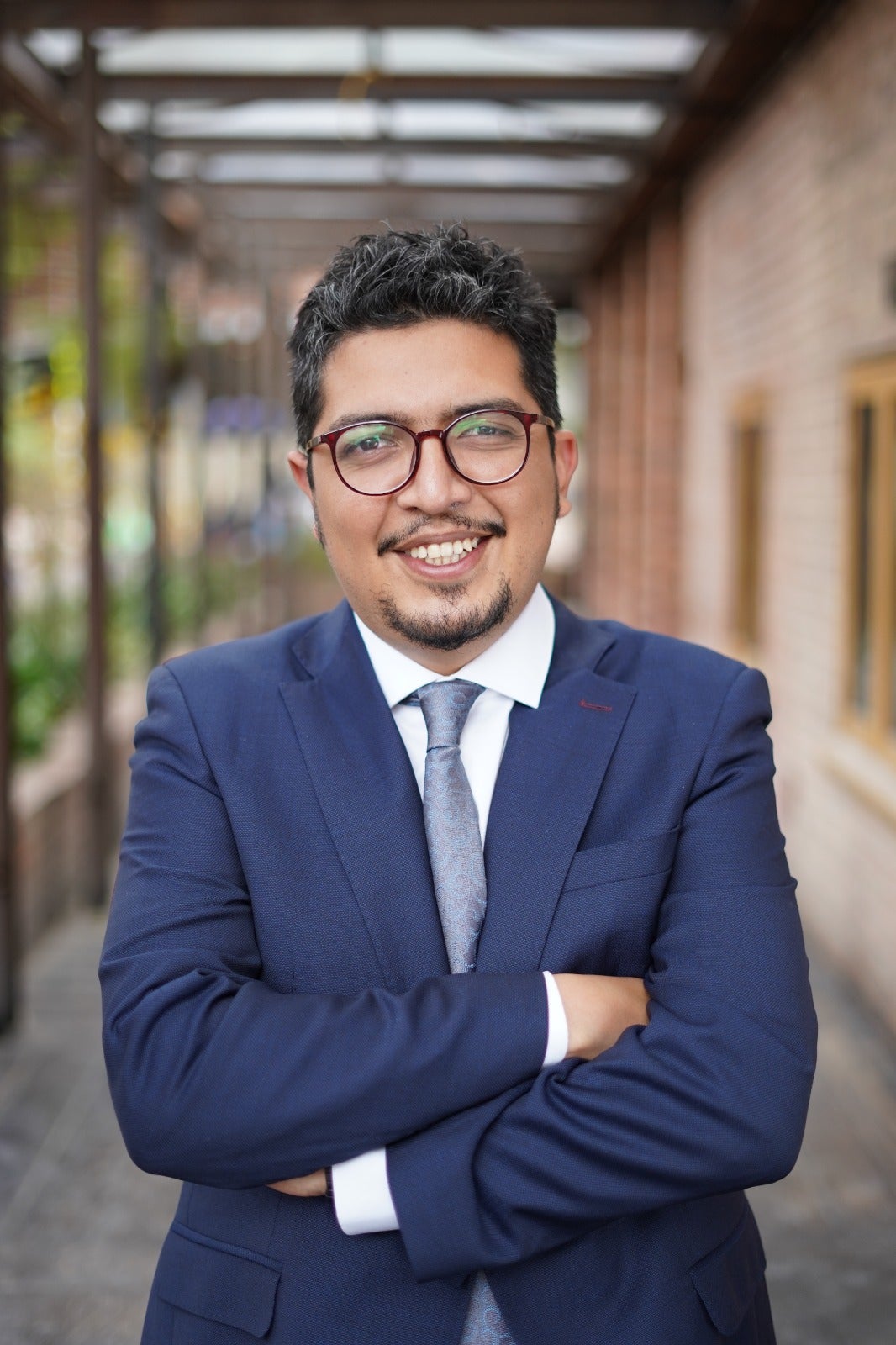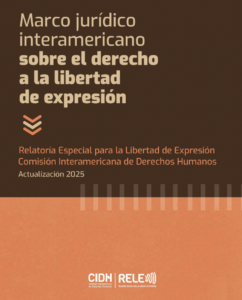Each year, the Inter-American Court of Human Rights (I/A Court H.R.) and the Inter-American Commission on Human Rights (IACHR) develop human rights standards through their rulings, resolutions and reports that the states of the hemisphere should adopt to ensure the full exercise of these rights.
In 2009, the IACHR's Special Rapporteur for Freedom of Expression (SRFOE), under the mandate of Catalina Botero, published the document "Inter-American Legal Framework on the Right to Freedom of Expression," which systematized all the standards developed by the Court, the IACHR and the SRFOE itself.
The document, which has served as a "guide for navigating" these standards, "has been considered and used as a reference tool by various state and judicial actors for decision-making or updating their laws and judicial decisions that have sought to protect the right to freedom of expression," current Special Rapporteur Pedro Vaca told LatAm Journalism Review (LJR).

Pedro Vaca, Special Rapporteur for Freedom of Expression of the Inter-American Commission on Human Rights (IACHR). (Photo: IACHR)
As part of the celebration of RELE's 25th anniversary, Vaca and his team saw the need to update the document to incorporate the standards established over these 15 years and to continue providing guidance in “internal decision-making, including with the judiciary, public policy formulation, legislative initiatives, academic research and human rights advocacy activities, to name a few examples.”
Vaca spoke with LJR about the update released on July 1. The interview has been edited for clarity and length.
LJR: The document incorporates new standards developed over the last 15 years. What gaps did you begin to notice that led to the need to update it?
Pedro Vaca: In recent years, the inter-American system has made progress in decisions regarding the protection of journalists, including intersectional protections for gender; the protection and guarantees for whistleblowers; and the obligation to establish affirmative policies for community radio stations.
The need to specifically protect speech such as the denunciation of gender-based violence and the free expression of gender identity and sexual orientation was also highlighted. These were also years in which Inter-American jurisprudence developed considerably regarding the protection of the right to protest and the rejection of the use of criminal law to protect the honor of public officials.
The advancement of the internet and digital environments, as well as protection within this environment, has also led to decisions within the inter-American system. For example, the need to reflect on content moderation and internet governance has grown.
All of these day-to-day decisions should be integrated by States into their domestic regimes, so that the protection of freedom of expression and of the press is aligned with the decisions of the Inter-American system. Updating this document will allow decision-makers, whether legislative or judicial, to align themselves with the rulings of the Inter-American system and thus adequately respond to these contemporary challenges.
LJR: Of the standards included, which do you think have been adopted the least?
PV: I think a good way to understand which standards are the least internalized—whether due to the absence of a regulatory framework or its poor implementation, when it exists—is to consider the patterns of violations that exist in the region. The 2024 Annual Report of the Special Rapporteur identifies these regional patterns in Chapter III, which I encourage you to read.
Given our limitations of space, let me address two topics: journalism and the internet.
Violence against the press and the murders of journalists remain a constant in the region, circumstances that have also led to forced displacement and exile. Covering social protests is a risk for the press, with reports of attacks and arrests against journalists carrying out their work. Reporting on matters of public interest is also affected by judicialization in the form of strategic lawsuits against public participation. Likewise, stigmatizing statements against the press by high-ranking public officials persist. In many countries, the allocation of official advertising remains unclear, making it easy to use as a mechanism to punish or reward certain editorial lines.
Regarding the internet, the gaps in adoption are in the standards related to the duties of digital literacy for the development of civic skills. We see States very focused on urgently resolving issues such as content moderation on networks, the scheme for assigning responsibilities to social networks and other platforms, the control of artificial intelligence, the widespread (and sometimes uncritical) use of digital technologies in public service delivery structures, and the expansion of network infrastructure as a way to reduce the digital divide. These are all important issues, but it seems that digital literacy, which is a foundational task and contributes to countering hate speech, disinformation and many other problems, occupies a low place on the list of priorities. It is true that the results of digital literacy are not immediate, but it is becoming an increasingly urgent need. The Legal Framework recalls some standards, which can be complemented by reading the SRFOE’s reports on the internet, especially the 2024 report on Digital Inclusion and Internet Content Governance.
LJR: In the case of journalism and in line with the previous question, which would be (or would be) the most significant at the regional level?
PV: Allow me to mention three standards.
First, the use of criminal law and its relationship to freedom of expression concerns me. There is a direct relationship between journalism and the development of Inter-American standards in this area because the first cases and many of those that followed dealt with journalistic activity. I believe that the entire jurisprudential development regarding the incompatibility of using criminal law to protect the honor of public officials, particularly when reporting on a matter of public interest, is the most significant standard. On the one hand, because it is the most developed issue in the cases of the [Inter American System of Human Rights] and the Inter-American Court today and is the central theme in several of the reports and rulings. On the other hand, because the phenomenon of judicialization is one of the most persistent in the hemisphere, this is a highly important standard for the defense of journalistic work in the region, which, in essence, plays this guardian role, informing citizens about matters of general interest.
Speaking of judicialization, cases that do not involve the application of criminal law, but rather the imposition of disproportionate civil penalties, are also gaining importance. In one of these recent cases—Moyá Chacón v. Costa Rica—the Court highlighted a standard that must always be present for those exercising public office when adopting policies and decisions: for journalism to exist, there must be a certain margin for error. This applies even to the most diligent journalism. The way to protect this margin is to prioritize the right to rectification and reply as the first means of resolving disputes and, if necessary, assign subsequent liability in a highly proportional manner.

The updated edition of the “Inter-American Legal Framework on the Right to Freedom of Expression” is available in Spanish. The English version will be made available in due course, acorrding to the Office of the Special Rapporteur. (Screenshot)
Finally, something often forgotten in debates about the right to freedom of expression and the American Convention is the role of prohibitions on indirect restrictions. Generally, when one thinks of restrictions on freedom of expression, a classic formula comes to mind: a State imposes a restrictive order, justifying that an individual committed an abuse. However, arbitrarily, States can use other legal mechanisms and other powers, in principle with the aim of protecting legitimate ends, to actually sanction and sustain reprisals against journalism. Denying access to airwaves, controlling paper and supplies—such as access to electricity—changing rules so that a person can own a media outlet, and arbitrarily using taxation powers are all examples of indirect mechanisms. In a world where the forms of restriction on the right to freedom of expression are becoming more sophisticated, it is important to redouble attention paid to the standards for prohibiting indirect censorship.
LJR: Specifically regarding abuse of the justice system, the document speaks of “strategic lawsuits against public participation (SLAPP) as categories of analysis in the inter-American standards.” What do the standards establish on this issue, considering that it is one of the main concerns in the region right now?
PV: The Annual Reports of the Special Rapporteur and various cases reported to the Special Rapporteur are related to this type of lawsuit, which seeks to silence and stifle those who criticize, question or publish information of public interest, which may be uncomfortable for those in power.
Generally speaking, at the current level of development of the Inter-American System, the standards identify that this practice constitutes an abuse of judicial mechanisms and, therefore, must be regulated and controlled by the State. It is therefore a duty to adopt anti-SLAPP measures. However, SLAPPs are a very interesting example because they also demonstrate how international human rights law evolves. Today, the Inter-American System does not have such specific guidelines on what these measures would be, but the System is constantly evolving. For example, in the recent Advisory Opinion 32/25, published last week, the Court identified State obligations regarding the duty to prevent and mitigate "judicial harassment" against human rights defenders. I believe this could be useful for the protection of other activities subject to SLAPPs, such as journalism. We also hope that the Inter-American Court can continue to make progress on this issue in future cases.
In 2024, the IACHR filed a case regarding a lawsuit against a journalist in Paraguay, and we hope this case can serve as a landmark for anti-SLAPP jurisprudence in the Inter-American Court.